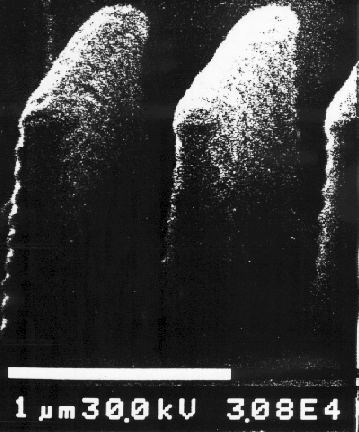
Which brings us to the next factor of 1000 in size, to the micrometre range that's the heart of microchip technology. All of these RAMs and ROMs and microprocessors have feature sizes on the order of micrometres. The entire march of processor technology I showed in the timing slide is essentially the story of learning to shrink our circuits from the order of tens of micrometres to single micrometres, and the frontier of electronics in the next several years will be shrinking further, down to fractions of a micrometre.
And then what?
Well, that's a very interesting question.

Here's a piece of silicon that's been machined into slabs a third of a micrometre wide. This is about the best we can do right now with conventional processing technology, and to give an indication of just how tiny that is, each of those slabs is smaller than the wavelength of deep violet light.
Needless to say, this image is from an electron microscope, not an optical one.
All the way down to micrometres, we've been able to design circuits essentially the way we did in the days of vacuum tubes. Yes, the devices and fabrication technologies changed, but the rules of the game like Ohm's law remained the same.
Somewhere between half a micrometre and a tenth of a micrometre, these comfortable assumptions begin to break down. The weird world of quantum mechanics, where the wave nature of the electron becomes apparent, begins to become manifest at this scale and straightforward shrinking doesn't seem likely to work.
This suggests we're already uncomfortably near the top of the curve for conventional electronics.